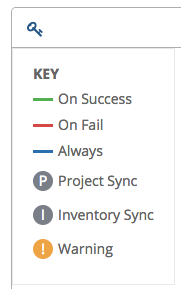16. Workflow Job Templates¶
A workflow job template links together a sequence of disparate job templates that accomplishes the task of tracking the full set of jobs that were part of the release process as a single unit.
The (![]() ) menu opens a list of the workflow and job templates that are currently available. The workflow/job template list is sorted alphabetically by name but you can search by various fields and attributes of the workflow/job template. The workflow/job template list also enables you to launch, copy, and remove a job template.
) menu opens a list of the workflow and job templates that are currently available. The workflow/job template list is sorted alphabetically by name but you can search by various fields and attributes of the workflow/job template. The workflow/job template list also enables you to launch, copy, and remove a job template.
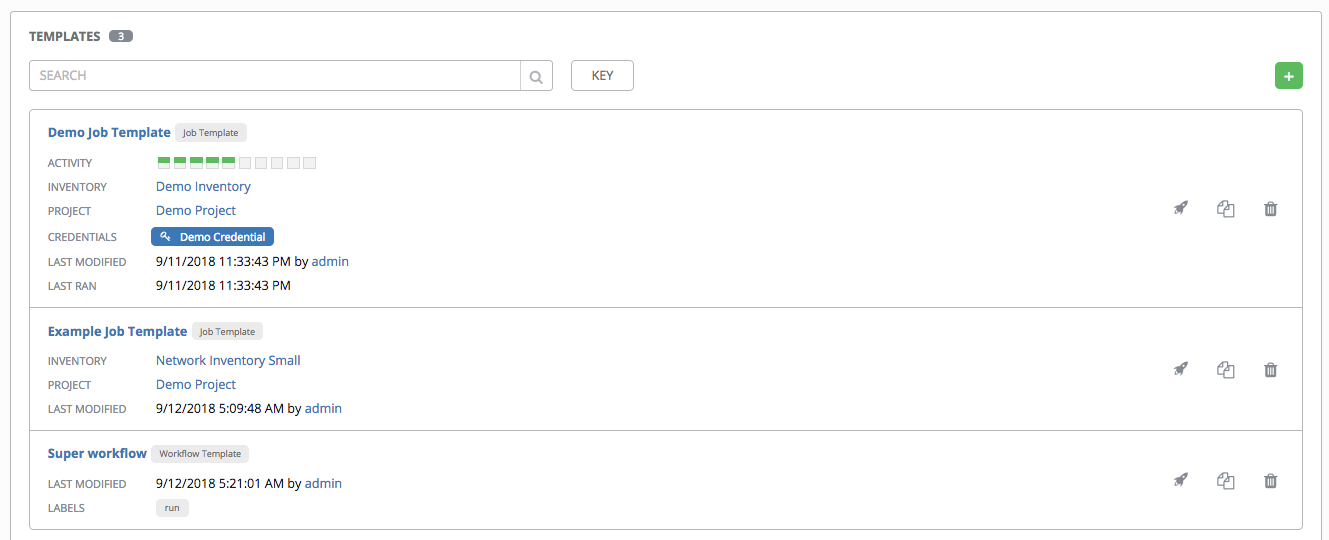
16.1. Create a Workflow Template¶
To create a new workflow job template:
- Click the
 button then select Workflow Job Template from the menu list.
button then select Workflow Job Template from the menu list.
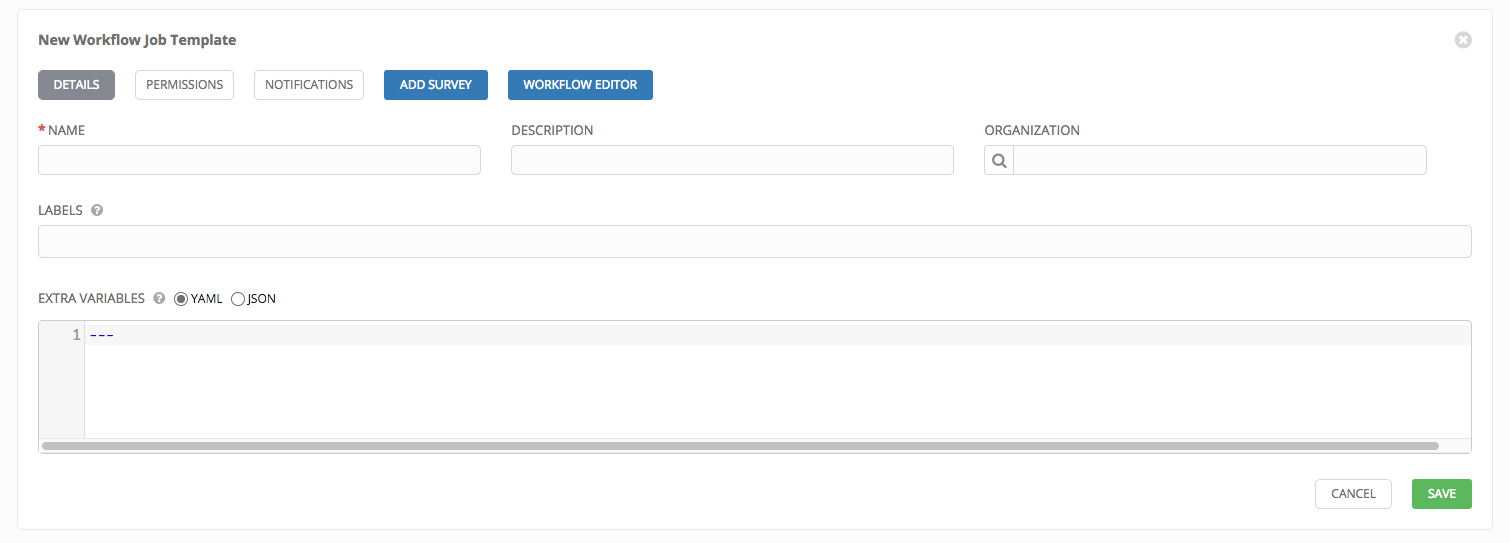
- Enter the appropriate details into the following fields:
- Name: Enter a name for the workflow template.
- Description: Enter an arbitrary description as appropriate (optional).
- Organization: Enter or search for an organization to associate the workflow.
- Labels: Supply optional labels that describe this workflow template, such as “dev” or “test”. Labels can be used to group and filter workflow templates and completed jobs in the Tower display.
- Labels are created when they are added to the Workflow Template. Labels are associated to a single Organization using the Project that is provided in the Workflow Template. Members of the Organization can create labels on a Workflow Template if they have edit permissions (such as an admin role).
- Once the Workflow Template is saved, the labels appear in the Templates overview.
- Click on the “x” beside a label to remove it. When a label is removed, and is no longer associated with a Workflow or Workflow Template, the label is permanently deleted from the list of Organization labels.
- Jobs inherit labels from the Workflow Template at the time of launch. If a label is deleted from a Workflow Template, it is also deleted from the Job.


Extra Variables:
Pass extra command line variables to the playbook. This is the “-e” or “–extra-vars” command line parameter for ansible-playbook that is documented in the Ansible documentation at Passing Variables on the Command Line.
Provide key/value pairs using either YAML or JSON. These variables have a maximum value of precedence and overrides other variables specified elsewhere. An example value might be:
git_branch: production release_version: 1.5
For more information about extra variables, refer to Extra Variables.
- When you have completed configuring the workflow job template, select Save.
Saving the template does not exit the Workflow Job Template page but remains on the Workflow Job Template Details view for further editing, if necessary. The Details tab of a saved template allows you to review, edit, and add permissions, notifications, surveys, or build a workflow job template using an editor.
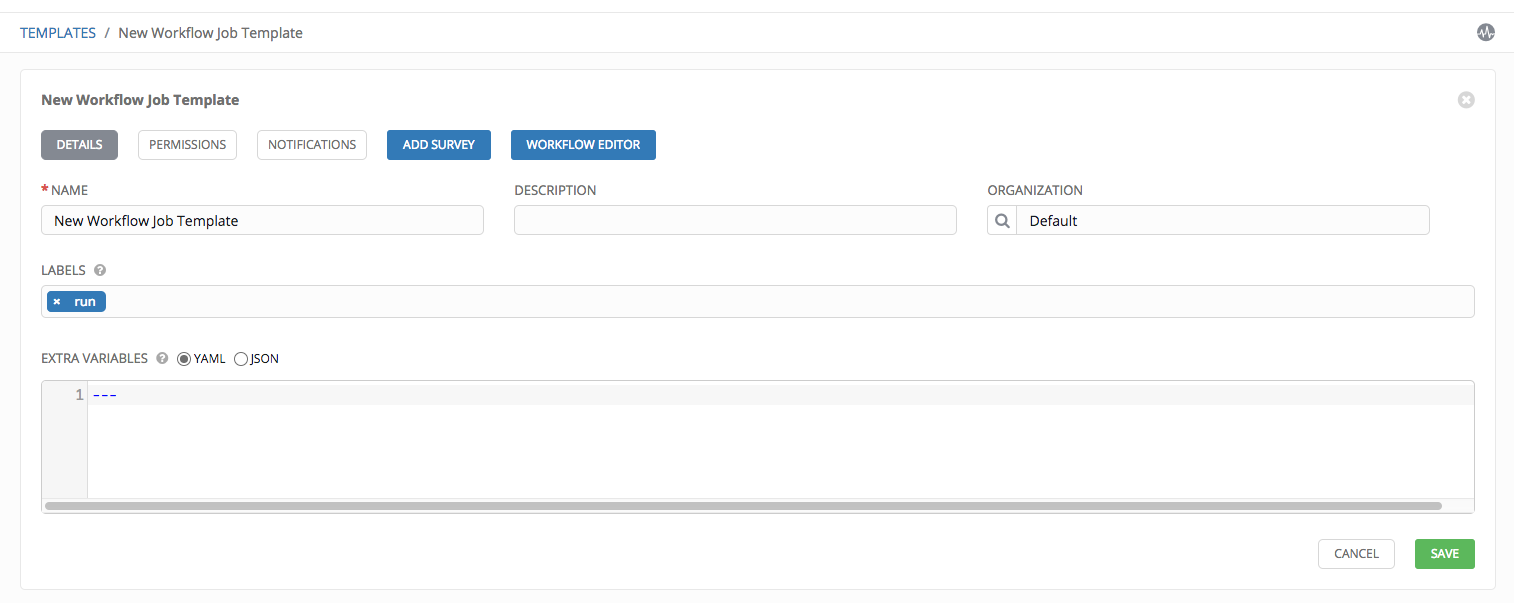
You can verify the template is saved when the newly created workflow job template appears on the list of templates at the bottom of the screen.
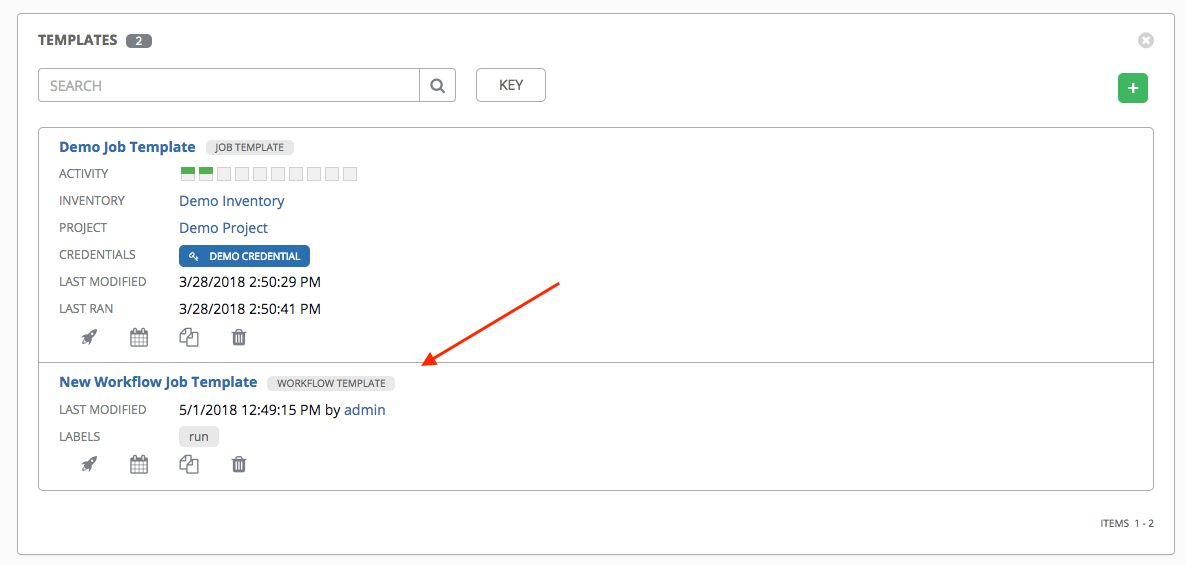
16.2. Work with Permissions¶
Clicking on Permissions allows you to review, grant, edit, and remove associated permissions for users as well as team members.

Click the  button to create new permissions for this workflow job template.
button to create new permissions for this workflow job template.
In this example, two users and one team have been selected and each have been granted permissions for this Workflow Template.
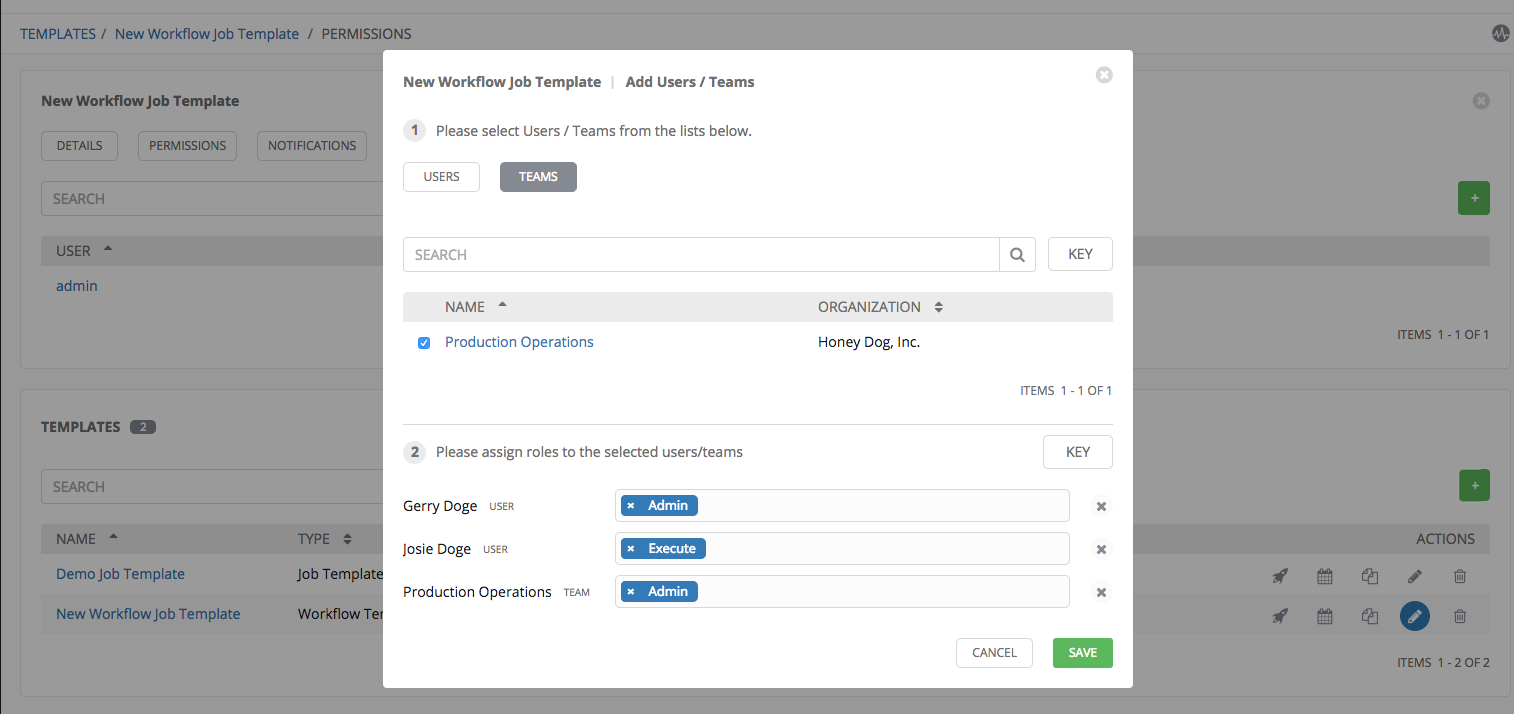
Note that you do not have to choose between teams or users, and that you can assign permissions to both at the same time.
16.3. Work with Notifications¶
Clicking on Notifications allows you to review any notification integrations you have setup.
Clicking on Notifications (beside Users when viewing your organization), allows you to easily manage notifications for this organization. If no notifications have been set up, click the NOTIFICATIONS link from above or inside the gray box to add or create a new notification.
Refer to Notifications for more information.
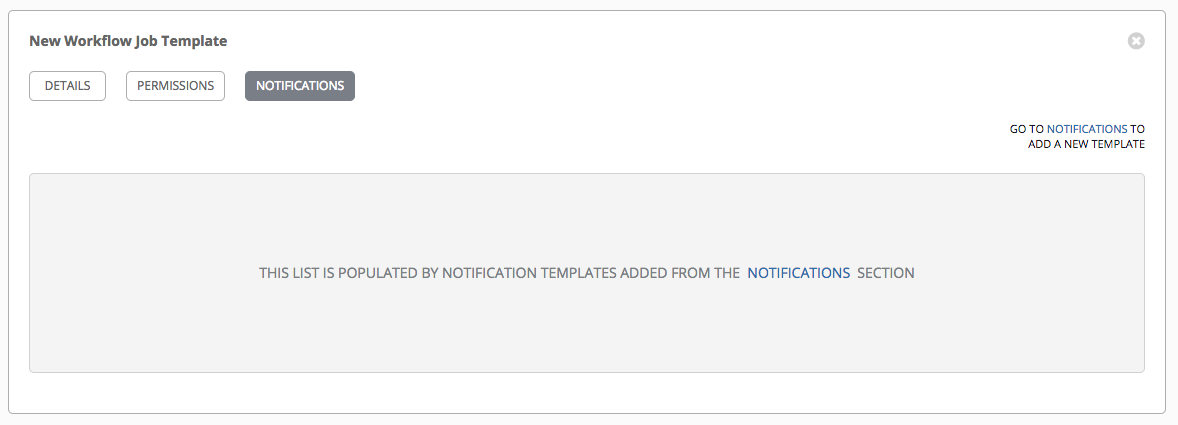
16.4. Work with Schedules¶
Clicking on Schedules allows you to review any schedules set up for this template.

From this view, you can select schedules to edit, turn on or off, or select multiple schedules to delete.
This screen displays a list of the schedules that are currently available for the selected Project. The schedule list may be sorted and searched by Name.
The list of schedules includes:
- Name: Clicking the schedule name opens the Edit Schedule dialog
- First Run: The first scheduled run of this task
- Next Run: The next scheduled run of this task
- Final Run: If the task has an end date, this is the last scheduled run of the task
- Last Modified: The last time this schedule was modified
16.4.1. Schedule a Workflow Job Template¶
To create a new schedule:
- From the Schedules screen, click the
 button.
button. - Enter the appropriate details into the following fields:
- Name
- Start Date
- Start Time
- Local Time Zone: the entered Start Time should be in this timezone
- Repeat Frequency: the appropriate options display as the update frequency is modified
Note
Jobs are scheduled in UTC. Repeating jobs that runs at a specific time of day may move relative to a local timezone when Daylight Saving Time shifts occur.
The Schedule Description below displays the specifics of the schedule and a list of the scheduled occurrences in the selected Local Time Zone.

- When satisfied with the schedule specifics, click Save.
Once the schedule is saved, the list of schedules display for the associated workflow job template.

Use the ON/OFF toggle button to quickly activate or deactivate this schedule.
16.5. Surveys¶
Workflows containing job types of Run or Check provide a way to set up surveys in the Workflow Job Template creation or editing screens. Surveys set extra variables for the playbook similar to ‘Prompt for Extra Variables’ does, but in a user-friendly question and answer way. Surveys also allow for validation of user input. Click the  button to create a survey.
button to create a survey.
Use cases for surveys are numerous. An example might be if operations wanted to give developers a “push to stage” button they could run without advanced Ansible knowledge. When launched, this task could prompt for answers to questions such as, “What tag should we release?”
Many types of questions can be asked, including multiple-choice questions.
Note
Surveys are only available to those with Enterprise-level licenses.
16.5.1. Create a Survey¶
To create a survey:
- Click on the
 button to bring up the Add Survey window.
button to bring up the Add Survey window.
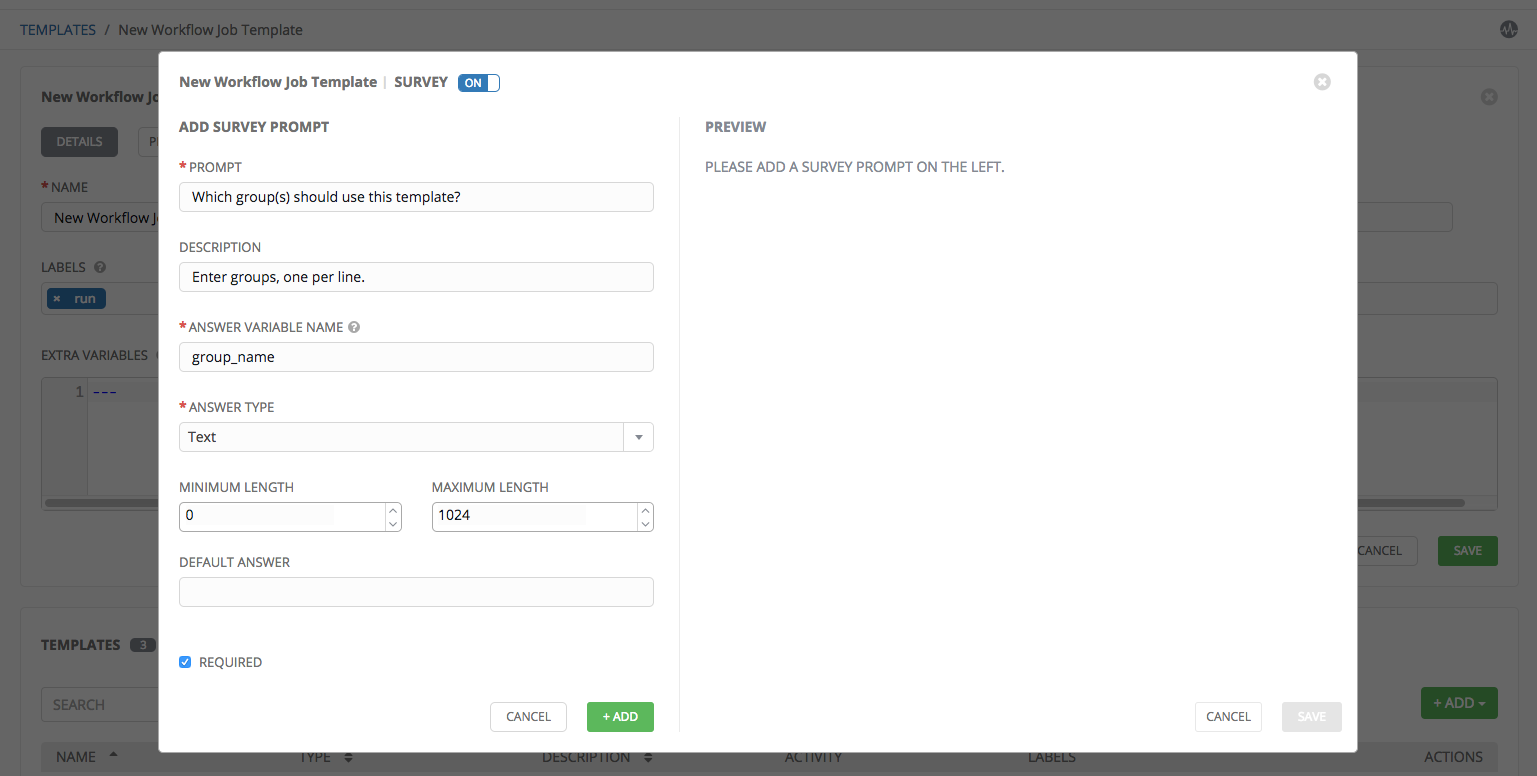
Use the ON/OFF toggle button at the top of the screen to quickly activate or deactivate this survey prompt.
- A survey can consist of any number of questions. For each question, enter the following information:
- Name: The question to ask the user.
- Description: (optional) A description of what’s being asked of the user.
- Answer Variable Name: The Ansible variable name to store the user’s response in. This is the variable to be used by the playbook. Variable names cannot contain spaces.
- Answer Type: Choose from the following question types.
- Text: A single line of text. You can set the minimum and maximum length (in characters) for this answer.
- Textarea: A multi-line text field. You can set the minimum and maximum length (in characters) for this answer.
- Password: Responses are treated as sensitive information, much like an actual password is treated. You can set the minimum and maximum length (in characters) for this answer.
- Multiple Choice (single select): A list of options, of which only one can be selected at a time. Enter the options, one per line, in the Multiple Choice Options box.
- Multiple Choice (multiple select): A list of options, any number of which can be selected at a time. Enter the options, one per line, in the Multiple Choice Options box.
- Integer: An integer number. You can set the minimum and maximum length (in characters) for this answer.
- Float: A decimal number. You can set the minimum and maximum length (in characters) for this answer.
- Default Answer: The default answer to the question. This value is pre-filled in the interface and is used if the answer is not provided by the user.
- Required: Whether or not an answer to this question is required from the user.
- Once you have entered the question information, click the
 button to add the question.
button to add the question.
A stylized version of the survey is presented in the Preview pane. For any question, you can click on the Edit button to edit the question, the Delete button to delete the question, and click and drag on the grid icon to rearrange the order of the questions.
- Return to the left pane to add additional questions.
- When done, click Save to save the survey.

16.5.2. Optional Survey Questions¶
The Required setting on a survey question determines whether the answer is optional or not for the user interacting with it.
Behind the scenes, optional survey variables can be passed to the playbook in extra_vars, even when they aren’t filled in.
- If a non-text variable (input type) is marked as optional, and is not filled in, no survey
extra_varis passed to the playbook. - If a text input or text area input is marked as optional, is not filled in, and has a minimum
length > 0, no surveyextra_varis passed to the playbook. - If a text input or text area input is marked as optional, is not filled in, and has a minimum
length === 0, that surveyextra_varis passed to the playbook, with the value set to an empty string ( “” ).
16.6. Workflow Visualizer¶
Starting with Ansible Tower 3.1, the Workflow Visualizer provides a graphical way of linking together job templates, project syncs, and inventory syncs to build a workflow job template.
16.6.1. Build a Workflow¶
Make sure you have any combination of two of the following templates to build a workflow: jobs, project sync, or inventory sync.
- In the details/edit view of a workflow job template, click the
 button to launch the Workflow Visualizer.
button to launch the Workflow Visualizer.

- Click the
 button to display a list of templates to add to your workflow.
button to display a list of templates to add to your workflow.
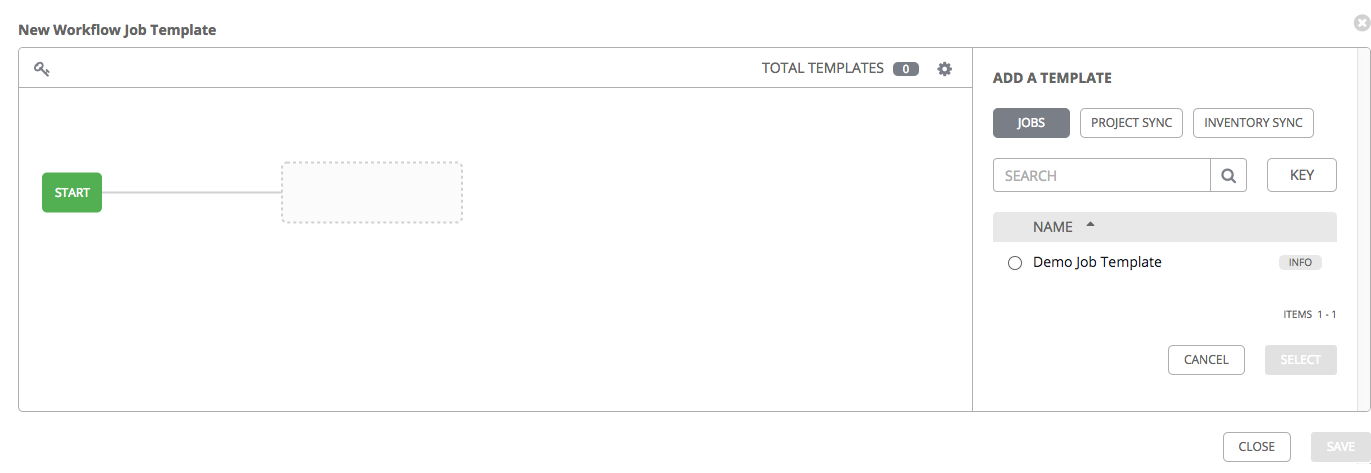
- On the right pane, select a template from the list of templates to add. To switch between jobs, project syncs, and inventory syncs, click the appropriate button above. Each template added represents a node.
Note
You will not be able to select job templates that don’t have a default inventory when populating a workflow graph. Though credential is not required in a job template, you will not be able to choose a job template for your workflow if it has a credential that requires a password, unless the credential is replaced by a prompted credential.
- Once a template is selected, the workflow begins to build, and a prompt appears, requesting for the type of action to be taken for the selected template:

- Select one of the following scenarios (edge type) to apply to this template:
- On Success: Upon successful completion, execute the next template.
- On Failure: Upon failure, execute a different template.
- Always: Continue to execute regardless of success or failure.
- If a job template used in the workflow has Prompt on Launch selected for any of its parameters, a Prompt button appears, allowing you to change those values at the node level. Use the wizard to change the value(s) and click Confirm.
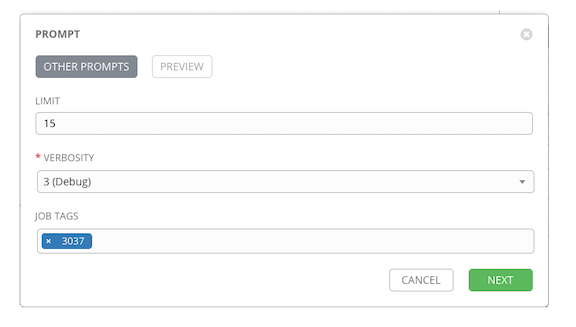
Note
For job templates with promptable fields that are required, but don’t have a default, you must provide those values when creating a node before the Select button becomes enabled. The two cases that disable the Select button until a value is provided via the Prompt button: 1) when you select the Prompt on Launch checkbox in a job template, but do not provide a default, or 2) when you create a survey question that is required but don’t provide a default answer. However, this is NOT the case with credentials. Credentials that require a password on launch are not permitted when creating a workflow node, since everything needed to launch the node must be provided when the node is created. So, if a job template prompts for credentials, Tower prevents you from being able to select a credential that requires a password.
You must also click Select when the prompt wizard closes in order to apply the changes at that node. Otherwise, any changes you make will revert back to the values set in the actual job template.
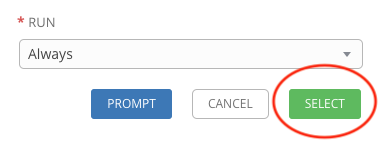
A template that is associated with each workflow node will run based on the selected run scenario as it proceeds. Click the key icon to display the legend for each run scenario and their job types.
Hovering over the node allows you to delete the selected node  , or add another one
, or add another one  .
.

Note
If you create a workflow job template with any number of strung-together job templates or job/inventory syncs, and one of those are deleted from your inventory of resources (the resource no longer exists), returning to the Workflow Visualizer for the affected workflow job template will show the missing resource as an incomplete node.

To fix the incomplete node, update it with a new job template or delete it from the workflow.
You can insert another node in between nodes and drag the diagram to depict a split scenario:

If you want to undo the last inserted node, when the right pane opens, click Cancel or proceed to click on another node without selecting from the right pane.
If you want to edit a node, click on the node you want to edit and the right pane displays the current selections. Make your changes and click Select to apply them to the graphical view.
Below is an example of a workflow that contains all three types of jobs that is initiated by a job template that if it fails to run, proceed to the project sync job, and regardless of whether that fails or succeeds, proceed to the inventory sync job.

Use the Key at the top of the window to identify the meaning of the symbols and colors associated with the graphical depiction.
You may add multiple nodes from the same parent node, creating sibling nodes:

Note
In a workflow with a set of sibling steps having varying edge types, and one of those siblings has a follow-on step attached to it, gets removed from the workflow:

The follow-on step will automatically join the set of sibling steps. If there is more than one edge type among the now-siblings, an edge conflict occurs:
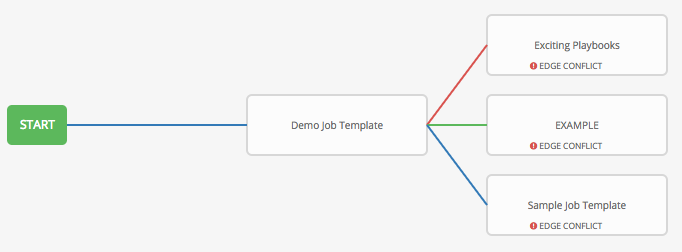
You must resolve this conflict before you can save the workflow job template. To resolve the conflict, make all the siblings have the same edge types.
Click the settings icon ( ) to zoom, pan, or reposition the view. Drag the workflow diagram to reposition it on the screen.
) to zoom, pan, or reposition the view. Drag the workflow diagram to reposition it on the screen.
- When done adding/editing a node, click Select to save any modifications and render it on the graphical view.
Important
Clicking Close on this pane will not save your work, but instead, closes the entire Workflow Visualizer and you will have to start over.
- When done with building your workflow job template, click Save to save your entire workflow job template and return to the new Workflow Template details page.
16.7. Launch a Workflow Job Template¶
To launch the workflow job template:
- Access the workflow job template from the Templates navigational link or while in the Workflow Job Template Details view, scroll to the bottom to access it from a list of templates.

- Click the
 icon next to the workflow you want to launch.
icon next to the workflow you want to launch.
Along with any extra variables set in the job template and survey, Tower automatically adds the same variables as those added for a job template upon launch. Additionally, Tower automatically redirects the web browser to the Jobs Details page for this job, displaying the progress and the results.
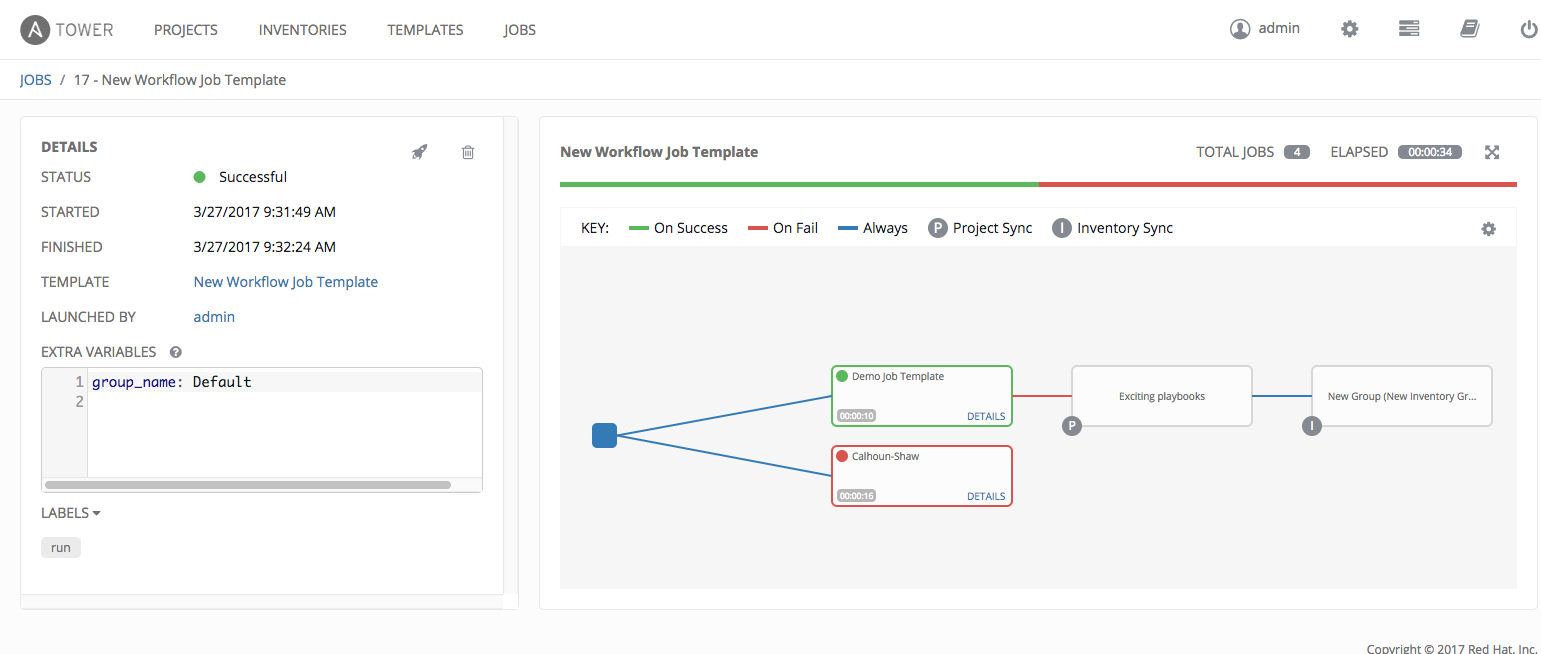
16.8. Copy a Workflow Job Template¶
Ansible Tower allows you the ability to copy a workflow job template. If you choose to copy a workflow job template, it does not copy any associated schedule, notifications, or permissions. Schedules and notifications must be recreated by the user or admin creating the copy of the workflow job template. The user copying the workflow job template will be granted the admin permission, but no permissions are assigned (copied) to the workflow job template.
- Access the workflow job template that you want to copy from the Templates navigational link or while in the Workflow Job Template Details view, scroll to the bottom to access it from a list of templates.

- Click the
 button.
button.
A new template opens with the name of the template from which you copied and a timestamp.
Replace the contents of the Name field with a new name, and provide or modify the entries in the other fields to complete this page.
- Click Save when done.
Note
If a resource has a related resource that you don’t have the right level of permission to, you cannot copy the resource, such as in the case where a project uses a credential that a current user only has Read access. However, for a workflow job template, if any of its nodes uses an unauthorized job template, inventory, or credential, the workflow job template can still be copied. But in the copied workflow job template, the corresponding fields in the workflow job template node will be absent.
16.9. Extra Variables¶
Note
Additional strict extra_vars validation was added in Ansible Tower 3.0.0. extra_vars passed to the job launch API are only honored if one of the following is true:
- They correspond to variables in an enabled survey
ask_variables_on_launchis set to True
When you pass survey variables, they are passed as extra variables (extra_vars) within Tower. This can be tricky, as passing extra variables to a workflow template (as you would do with a survey) can override other variables being passed from the inventory and project.
For example, say that you have a defined variable for an inventory for debug = true. It is entirely possible that this variable, debug = true, can be overridden in a workflow template survey.
To ensure that the variables you need to pass are not overridden, ensure they are included by redefining them in the survey. Keep in mind that extra variables can be defined at the inventory, group, and host levels.
The following table notes the behavior (hierarchy) of variable precedence in Ansible Tower as it compares to variable precedence in Ansible.
Ansible Tower Variable Precedence Hierarchy (last listed wins)


